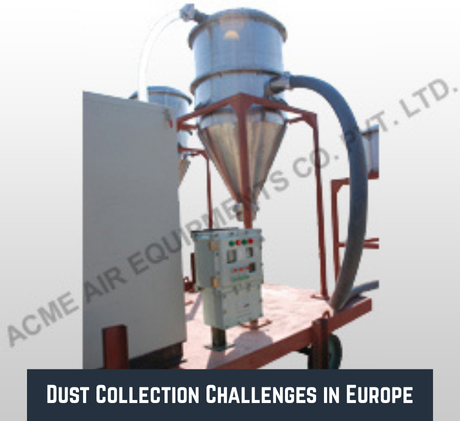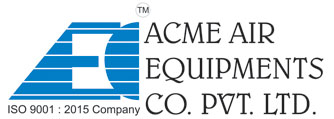Table of Contents
In the manufacturing sector, particularly in Europe, effective dust management is a critical concern. Dust collection systems play an essential role in ensuring clean air, maintaining a safe working environment and improving operational efficiency. With industries in Europe facing increased regulatory pressure, rising environmental concerns and heightened health and safety standards, there are numerous challenges and opportunities for dust collection systems.
The increasing demand for automation and efficiency in manufacturing also drives the need for advanced dust collection units. As industries scale and expand, especially in sectors such as automotive, pharmaceuticals, food processing and metalworking, the role of dust collector systems becomes even more pronounced. However, adopting and maintaining these systems involves several challenges, alongside emerging opportunities for innovation and growth.
In this article, we will explore these challenges and opportunities that European manufacturers face in utilizing dust collection systems and how they are adapting to meet the growing demands of modern manufacturing.
What Are the Key Challenges for Dust Collection Systems in European Manufacturing?
The adoption and effective integration of dust collection systems in European manufacturing face several challenges that must be addressed to optimize performance and ensure compliance with stringent regulations. Let’s examine these key challenges:
Stringent Environmental Regulations
Europe is known for its strict environmental regulations aimed at reducing air pollution, protecting workers’ health and minimizing industrial waste. Regulations such as the European Union’s and the European Commission’s air quality standards require manufacturers to implement robust Dust Collection Systems that can meet high standards of efficiency and pollutant reduction.
Manufacturers are often tasked with investing in advanced dust collector systems that ensure compliance with these regulations. Failing to do so can lead to costly fines and reputational damage. The challenge lies in designing systems that can meet evolving environmental standards without drastically increasing operational costs.

Increasing Demand for Energy Efficiency
Energy consumption is one of the largest operational costs in manufacturing plants. Central dust collection systems, can consume significant amounts of energy to maintain airflow, pressure and filtration. As industries become more focused on energy efficiency and cost reduction, manufacturers are seeking solutions that can provide the same or higher levels of filtration and dust removal while minimizing energy consumption.
Designing energy-efficient dust collector systems requires careful consideration of system components, such as motors, fans and filters, to ensure they operate with minimal energy expenditure while maintaining optimal performance.
High Maintenance and Operational Costs
Dust collection systems require regular maintenance, including filter replacements, cleaning and checks on fans and motors to ensure continued efficiency. The complexity of dust collector units means that manufacturers need to invest in skilled personnel and resources to keep these systems running efficiently. In high-demand manufacturing environments, downtime caused by system failures or inefficiencies can result in significant production losses.
The challenge for manufacturers is to balance the high initial investment and ongoing maintenance costs of dust collection systems with the operational savings and improved worker safety that these systems provide.
Managing Increasing Dust Volumes in Expanding Operations
As European manufacturing expands, the volume of dust generated by production processes increases. Industries such as metalworking, woodworking and food production often produce large amounts of dust that can be difficult to capture and filter effectively.
Dust collector systems need to be scalable and adaptable to meet the demands of growing operations. However, designing a system that can handle varying dust volumes while maintaining consistent airflow, filtering capacity and energy efficiency presents a significant challenge. Manufacturers need to invest in flexible and modular systems that can be expanded as production levels rise.
Ensuring Worker Safety and Health Compliance
Workplace health and safety regulations in Europe are among the strictest globally. With dust being a major contributor to respiratory diseases and other health issues, it is imperative for manufacturers to provide a safe working environment by controlling airborne dust. Failing to comply with health and safety regulations can lead to serious legal and financial consequences for manufacturers.
Dust collection systems must be designed to capture harmful dust particles efficiently and prevent them from entering the workplace air. However, ensuring the system’s efficiency and compliance with the various health and safety standards across industries can be challenging.
What Are the Key Opportunities for Dust Collection Systems in European Manufacturing?
While the challenges in the implementation and maintenance of Dust Collector Systems are significant, there are also a number of emerging opportunities for manufacturers to enhance their operations and improve their systems.
Technological Advancements in Filtration
With advancements in filtration technology, manufacturers can now choose from more efficient dust collection machine that deliver better performance with lower energy consumption. Innovations in filter materials, such as nanofiber filters, have enabled systems to capture finer dust particles, which is crucial for industries like pharmaceuticals and food production, where even small amounts of contaminants can affect product quality.
Additionally, new technologies such as smart sensors and predictive maintenance tools allow dust collection units to continuously monitor performance and alert operators to potential issues before they become critical, reducing downtime and maintenance costs.
Integration with Industry for Increased Efficiency
This trend is presenting significant opportunities for manufacturers to integrate dust collector systems into broader automated manufacturing systems. For example, central dust collection systems can be connected to plant-wide monitoring systems that track energy usage, air quality and maintenance needs in real-time. This integration enables data-driven decisions to optimize the operation of the dust collection systems, ensuring peak efficiency, reducing energy costs and minimizing downtime.
Investment in Modular, Scalable Systems
As European manufacturing grows and adapts to new production demands, the need for scalable dust collection systems is becoming more critical. Manufacturers are increasingly opting for modular systems that can be expanded or upgraded as needed, offering flexibility and cost-efficiency.
Modular dust collector units allow businesses to scale their operations while maintaining efficient dust control. These systems are particularly advantageous in industries like automotive manufacturing or metalworking, where production volumes can fluctuate and the dust load may vary depending on the work environment.
Improving Sustainability and Reducing Waste
With increasing emphasis on sustainability, manufacturers are focusing on reducing waste and improving the efficiency of their operations. Dust collection systems that offer better filtration can not only improve air quality but also help recover valuable materials from the dust, such as in the mining or metal industries.
For instance, dust collector systems in the recycling industry can help reclaim dust particles that contain valuable metals or other materials, enabling manufacturers to recycle these materials rather than dispose of them. This creates a more efficient, circular manufacturing process, turning waste into usable resources.
Emphasis on Worker Health and Safety
As workplace safety regulations become stricter, manufacturers are placing a greater emphasis on creating a safe and healthy working environment. Dust collection systems offer an opportunity to improve worker health by capturing harmful dust particles and preventing exposure to harmful chemicals or materials.
By investing in high-performance dust collectors, manufacturers not only ensure compliance with safety standards but also improve employee morale and productivity. Healthy workers lead to fewer sick days, lower insurance premiums and enhanced workforce efficiency.
Conclusion
The adoption of dust collection systems in European manufacturing comes with its set of challenges, including compliance with stringent regulations, managing high maintenance costs and addressing increasing dust volumes in expanding operations. However, the opportunities for growth and improvement are equally substantial. Technological advancements, the integration of Industry 4.0 and a focus on worker health and safety provide the means for manufacturers to overcome these challenges and optimize their operations.
By embracing these opportunities and addressing the challenges head-on, manufacturers in Europe can achieve greater operational efficiency, lower costs and a safer working environment. Dust collection systems will continue to play an integral role in shaping the future of European manufacturing, helping businesses meet their production goals while maintaining high standards of safety and environmental responsibility.
FAQs on Dust Collection Systems
What are dust collection systems used for in manufacturing?
Dust collection systems are used to capture and filter harmful dust and particulates from the air in industrial settings, ensuring a cleaner environment, improving worker health and maintaining regulatory compliance.
How do dust collectors improve air quality in manufacturing plants?
Dust collectors filter out harmful dust particles from the air, preventing them from being inhaled by workers and maintaining a cleaner, safer working environment.
What are the challenges of implementing dust collection systems in Europe?
Challenges include complying with stringent environmental and health regulations, managing high maintenance costs, reducing energy consumption and ensuring systems can handle increased dust volumes as plants scale up.
How can dust collection systems help reduce energy costs in manufacturing?
Energy-efficient dust collection systems are designed to reduce power consumption by optimizing airflow and filtration, minimizing energy waste while maintaining effective dust removal performance.
When should manufacturers invest in dust collection systems?
Manufacturers should invest in dust collection systems when increasing production volumes, expanding operations, upgrading equipment for energy efficiency or ensuring compliance with health and safety regulations.
About Author

CEO
Mr. Vishwesh Pardeshi is the CEO of Acme Air Equipments Company Pvt. Ltd., an industrial and engineering goods manufacturing company based in Ahmedabad, Gujarat (India). He has taken over the responsibility from founding Partners and Directors of the Company, and is now leading a talented group of professionals since 2020 by bringing in vast industrial and management expertise. By qualification, he holds a Bachelor Degree in Mechanical Engineering and also holds a MBA degree from reputed institutes. Under his leadership, the Company has successfully executed prestigious projects by delivering high quality and world class products from a state of the art manufacturing facility which combines CNC-enabled precision manufacturing and strong after sales support. In line with the Vision, Mission and Core Values of the Organization, Mr. Vishwesh Pardeshi continues to drive Quality, Reliability and Global Expansion at Acme Air Equipments Co. Pvt. Ltd.









